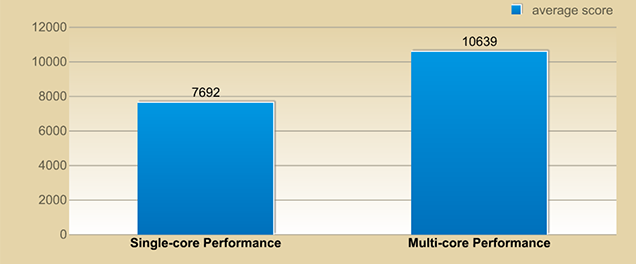
In this guide, we will consider the advantages and disadvantages of single-core vs multi-core performance for gaming. Multi-core CPUs are the most common form of CPUs used in gaming.
Performance per core
Processors come in multiple cores, which can offer dramatic increases in performance when compared to single-core CPUs of the same speed. Multiple cores make it easier to run multiple tasks simultaneously, making you more efficient when working on complex projects or using powerful applications.
Typically better single-core performance, but single-core performance doesn’t necessarily mean better multi-core performance. A single-core CPU is essentially a single processor within each core.
Performance is a term used to describe a software’s capacity to process data and send it to the user for processing. A single core is the most limited version that may be used in the software. This is because most things can be handled by one core.
However, it is possible that a core may not be enough for all tasks. For that reason, a multi-core may be used. This option is often used when software has many cores and most tasks can be handled with a single core.

So we’ve got this idea of dual-core and that’s because there is a limit to how fast we can run the process in terms of frequency mainly because of you know, all the electronic stuff and quantum tunneling and always kind of stuff and because of the power requirements.
Now one thing we have to understand is that each microprocessor has different performance characteristics not because of the frequency not because of the voltage but because of its design so if you take a cortex, let’s say a 75 and you run it at a certain frequency with a certain voltage and then you take this say Aquatics a 77 running at the same frequency at the same voltage a 77 will be faster and that’s because the internals of the chip is designed differently and it’s the same in the PC market each AMD generation that comes out, you know, the Rison and the Zen architectures always go and until the same the i-5 the i7 the tenth generation the ninth generation, it’s all these different generations.
There are a lot of ways to look at virtual performance. What are the best results for a single core system or a multi-core system? As far as the best performance for gaming, there’s no single answer that’s always correct.
There are also different types of virtualization. There’s also the question of how fast or slow your CPU is, how hot or cold your computer is, and so on.
What is a CPU core?
The core or core of the CPU is the “brain” of the CPU. It receives instructions and performs calculations, such as operations, to perform them. The CPU can have multiple cores.
What is single-core performance?
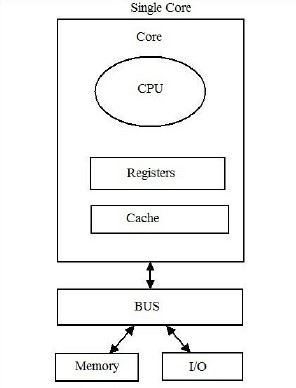
Single-core performance is CPU performance when you disable everything except one of its cores. This is important because not all programs or games can run faster using multiple cores; some things may be limited to implementing only one core or only two cores, etc.
Advantages
- Lower power consumption: Single-core processors consume less power than multi-core processors since they have only one core to power.
- Lower cost: Single-core processors are cheaper to manufacture than multi-core processors, which makes them more affordable for budget-conscious consumers.
- Less complex: Single-core processors are less complex than multi-core processors, which makes them easier to design and manufacture.
Disadvantages
- Slower performance: Single-core processors can only execute one task at a time, which means that they are slower than multi-core processors when it comes to multitasking.
- Less efficient: Single-core processors are less efficient than multi-core processors since they have to work harder to execute tasks.
- Obsolete: Single-core processors are becoming obsolete since most modern software and applications are designed to take advantage of multi-core processors.
Overall, single-core processors are still useful for basic computing tasks such as browsing the web, checking email, and word processing. However, for more demanding tasks such as gaming or video editing, multi-core processors are the better choice.
Here are some of the best Selling single-core processors on Amazon.
- SUPERIOR FUNCTION: The Cuisinart 4-cup mini chopper quickly chops and grinds with a patented auto-reversing stainless-steel SmartPower blade
- CONTROL: Chop or grind paddle controls with exclusive BladeLock system
- EASY CLEAN UP: Dishwasher-safe parts and lid for easy clean up, wipe the motor base clean with a damp sponge or cloth
- Simply stack and press to chop: The patented stack & press design makes it easy to assemble and use. Simply press the lid to chop and release to stop. Since all you do is stack the lid on top of the bowl, no difficult twist-locking is needed.
- Perfect size for everyday use: Chop and mix up to 3 cups of ingredients every day of the week with this 3 cup chopper. It's the perfect size for everyday use, yet small enough for easy storage.
- Easily chop, puree and emulsify with stainless steel blades: Durable stainless steel blades make easy work of a multitude of ingredients including onions, carrots and nuts. Oil dispenser on lid makes it easy to emulsify dressings, dips and sauces.
- Game Without Compromise. Play harder and work smarter with Intel Core 14th Gen processors
- 20 cores (8 P-cores + 12 E-cores) and 28 threads. Integrated Intel UHD Graphics 770 included
- Up to 5.6 GHz with Turbo Boost Max Technology 3.0 gives you smooth game play, high frame rates, and rapid responsiveness
- Personal Blender with 160W Copper Motor, efficient & fast, let you make healthy smoothies on the go.
- Heavy Duty Stainless Steel 4 Blades with rotation speed up to 20000rpm easily cut tough ingredients.
- Break Resistant BPA Food Grade Mixer Jar ensures healthy and safe drinking - 20 oz / 600 ml capacity.
- CPU Intel der 12. generation.
- Base frequency: 2.5 GHz
- Socket LGA1700.
- Game and multitask without compromise powered by Intel’s performance hybrid architecture on an unlocked processor.
- Integrated Intel UHD 770 Graphics
- Compatible with Intel 600 series and 700 series chipset-based motherboards
- 7-cup work bowl
- Control buttons for On & Pulse/Off
- Fine and medium reversible shredding / slicing disc
What is multi-core performance?
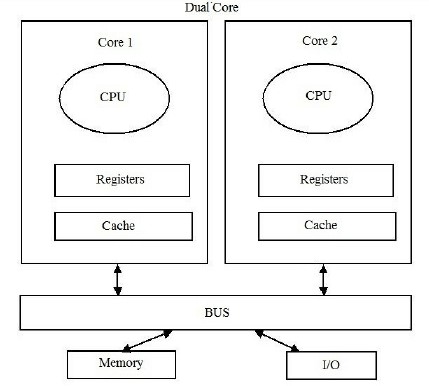
A CPU that offers multiple cores may be better than a single-core CPU of the same speed. Multiple cores allow computers to run multiple processes simultaneously much faster, which increases your performance when multitasking or as required by powerful applications and programs.
A dual-core processor is called a dual-core processor; with four cores, one quad-core; six nuclei, six-core; eight cores, eight-core. Most consumers had CPUs between two and twelve cores. Workstations and server CPUs can have approximately 48.
Each CPU core can perform operations differently than the others. Or, multiple cores can work together to perform parallel operations on a shared CPU cache data set.
Advantages
- One of the primary advantages of multi-core processors is their ability to execute multiple tasks simultaneously. This can significantly improve the performance of applications that are designed to take advantage of multithreading. Multi-threading is a programming technique that allows applications to divide their workload into smaller, independent tasks that can be executed in parallel.
- Another advantage of multi-core processors is their ability to handle heavy workloads. This is particularly important for applications that require a lot of processing power, such as video editing or scientific simulations. Multi-core processors can handle these tasks more efficiently than single-core processors, which can significantly reduce the time required to complete them.
- Multi-core processors also tend to be more energy-efficient than single-core processors. This is because they can distribute the workload across multiple cores, which reduces the amount of power required to complete each task. This can result in lower energy consumption and lower operating costs.
Disadvantages
- One of the primary disadvantages of multi-core processors is their cost. Multi-core processors tend to be more expensive than single-core processors, which can make them less accessible to consumers on a budget.
- Another disadvantage of multi-core processors is that they are not always necessary for everyday computing tasks. For example, browsing the web or checking email doesn’t require a lot of processing power, so a single-core processor may be sufficient for these tasks.
Finally, not all applications are designed to take advantage of multithreading. This means that some applications may not benefit from the additional cores provided by a multi-core processor. In some cases, a single-core processor may actually be more efficient for these applications.
Top 5 Multicore Processors
When it comes to high-performance computing, multicore processors are the way to go. They are designed to handle multiple tasks simultaneously, making them ideal for demanding applications such as video editing, gaming, and scientific simulations. Here are the top 5 best-selling multicore processors in 2023:
| Rank | Processor | Cores/Threads | Base Clock Speed | Boost Clock Speed |
|---|---|---|---|---|
| 1 | AMD Ryzen 9 5950X | 16/32 | 3.4 GHz | 4.9 GHz |
| 2 | Intel Core i9-11900K | 8/16 | 3.5 GHz | 5.3 GHz |
| 3 | AMD Ryzen 9 5900X | 12/24 | 3.7 GHz | 4.8 GHz |
| 4 | Intel Core i9-10900K | 10/20 | 3.7 GHz | 5.3 GHz |
| 5 | AMD Ryzen 7 5800X | 8/16 | 3.8 GHz | 4.7 GHz |
The AMD Ryzen 9 5950X is the clear winner in this category, with 16 cores and 32 threads, a base clock speed of 3.4 GHz, and a boost clock speed of 4.9 GHz. It is followed closely by the Intel Core i9-11900K, which has 8 cores and 16 threads, a base clock speed of 3.5 GHz, and a boost clock speed of 5.3 GHz.
The AMD Ryzen 9 5900X, Intel Core i9-10900K, and AMD Ryzen 7 5800X round out the top 5, each with its own strengths and weaknesses. The Ryzen 9 5900X has 12 cores and 24 threads, while the Intel Core i9-10900K has 10 cores and 20 threads. The Ryzen 7 5800X has 8 cores and 16 threads, making it a great choice for gaming.
Overall, these processors offer excellent performance for a wide range of applications and are highly recommended for anyone looking to build a high-end PC.
- CPU FREQUENCY: 2.0GHZ
- CPU MAX TURBO FREQUENCY: 3.675GHZ
- MULTI-CORE: 64-CORE
- CPU FREQUENCY: 2.2GHZ
- CPU MAX TURBO FREQUENCY: 3.5GHZ
- MULTI-CORE: 64-CORE
- CPU FREQUENCY: 2.80GHZ
- CPU MAX TURBO FREQUENCY: 3.90GHZ
- MULTI-CORE: 16-CORE
- CPU FREQUENCY: 2.20GHZ
- CPU MAX TURBO FREQUENCY: 3.20GHZ
- MULTI-CORE: 12-CORE
- CPU FREQUENCY: 2.10GHZ
- CPU MAX TURBO FREQUENCY: 3.30GHZ
- MULTI-CORE: 12-CORE
- AMD's fastest 8 core processor for mainstream desktop, with 16 procesing threads. OS Support-Windows 10 64-Bit Edition
- Can deliver elite 100-plus FPS performance in the world's most popular games
- Cooler not included, high-performance cooler recommended
- Essential performance and I/O expandability options for entry-level servers
- Support for modern server operating systems and compatible with common remote management toolsSpecifications
- Clock Speed: 3.20 GHz
Best Selling Single Core Processors
Top 5 Single-Core Processors
Single-core processors are designed to handle one task at a time, making them ideal for applications that require high single-threaded performance. Here are the top 5 best-selling single-core processors in 2023:
| Rank | Processor | Clock Speed | |
|---|---|---|---|
| 1 | Intel Core i9-9900K | 3.6 GHz | Check Current Price |
| 2 | AMD Ryzen 9 5950X | 3.4 GHz | Check Current Price |
| 3 | Intel Core i7-11700K | 3.6 GHz | Check Current Price |
| 4 | AMD Ryzen 7 5800X | 3.8 GHz | Check Current Price |
| 5 | Intel Core i5-11600K | 3.9 GHz | Check Current Price |
How many cores are Needed for gaming?
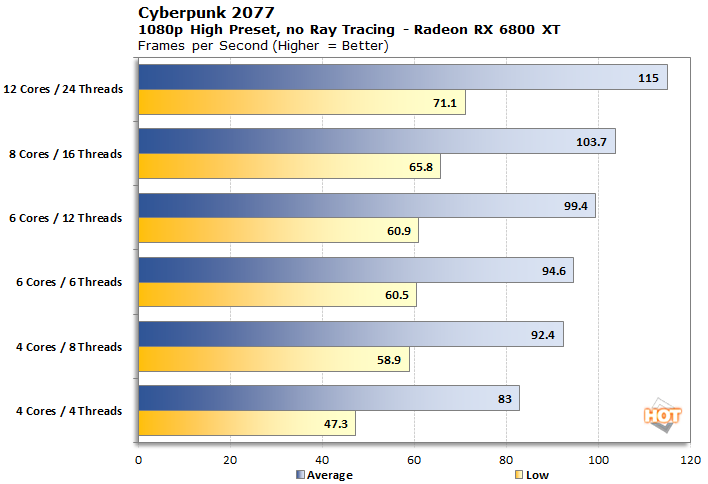
Overall, six cores are generally considered the best for gaming in 2022. Four cores may still hack it, but it’s hardly a solution for the future. Eight or more cores can provide performance gains, but it all depends on how a particular game is coded and which GPU pairs the CPU with it.
Is single-core performance important for gaming?
Single-core performance is even more important for gaming than multi-core performance. Since most games today will use multiple CPU cores, the number of cores cannot be ignored. … The main CPU choice for most midrange assemblies is the Intel Core i5-9600K or AMD Ryzen 5 3600X.
Single-core vs multi-core which is better?
A CPU that offers multiple cores may be better than a single-core CPU of the same speed. Multiple cores allow computers to run multiple processes simultaneously much faster, which increases your performance when multitasking or as required by powerful applications and programs.
Many games today use more cores than of course (quad-core CPUs seem to be the most common), and therefore experience faster and better FPS speeds. This is why you want to go for some higher-priced quad-core processors if they are not too expensive.
Performance Comparison
Single-core processors are designed to handle one task at a time, while multi-core processors can handle multiple tasks simultaneously. This means that multi-core processors have an advantage when it comes to multitasking and running multiple applications at once.
However, for tasks that require a lot of processing power, such as video editing or gaming, a single-core processor may be better suited. In terms of clock speed, single-core processors generally have higher clock speeds than multi-core processors.
This means that they can perform tasks faster, but they are limited to handling one task at a time. On the other hand, multi-core processors have lower clock speeds but can handle multiple tasks simultaneously, resulting in better overall performance.
Power Consumption Comparison
Single-core processors generally consume less power than multi-core processors. This is because they have fewer transistors and require less voltage to operate. However, multi-core processors are more energy-efficient when it comes to multitasking and running multiple applications simultaneously. This is because they can distribute the workload across multiple cores, reducing the overall power consumption.
Price Comparison
Single-core processors are generally less expensive than multi-core processors. This is because they have fewer transistors and require less complex manufacturing processes.
However, multi-core processors offer better overall performance and are more energy-efficient, making them a better investment in the long run.
Overall, the choice between a single-core and a multi-core processor depends on the specific needs of the user. For tasks that require a lot of processing power, a single-core processor may be better suited. However, for multitasking and running multiple applications simultaneously, a multi-core processor is the better choice.
Frequently Asked Questions
Is single-core or multi-core performance more important?
Single-core performance is important for software applications that do not have / cannot benefit from multiple processor cores. A CPU having multiple cores doesn’t mean faster, but if your application is optimized for multi-core use, it will run faster with multiple cores.
Why don’t all programs support multiple cores?
The reason why not all applications use multiple threads is that developing multiple threads is likely to be difficult. Writing many content applications correctly requires time, effort, and a lot of energy. Even when completed, many applications show no improvement.
Often, any application that spends most of its time waiting for user input comes with a kernel that is fine. Sometimes programs do not support multi-core CPUs because the programming logic needed to implement multi-core support can make the application more vulnerable.
I would think that “weak” in this context means more prone to freezing and falling.
This seems to be a programming problem. To use multiple cores, the application must be built from the beginning so that it can be used correctly. Some programming languages are better at providing this feature than others, but they require you to think differently about how you program.
What are CPU threads?
Discussions take this to the next level by dividing what we call a “logical core” (a physical core that is actually built into the CPU) into two separate cores using the intelligent software side of the CPU. The most important thing it does is double the number of cores in your CPU! Even if your processor has a number of cores built into it, your system will recognize it with a lot of tank threads. AMD calls its fiber technology Simultaneous Multi-Threading (SMT) and Intel calls it Hyper-Threading. Don’t worry, it’s the same.
Is 12 Core overkill for gaming?
No. An i7 like Ryzen 7 is more than enough to play. An i5 like Ryzen 5 is good for gaming, if you want to go for high-end games, then go for an i7 or Ryzen 7. A 6-core CPU is good for middle-class games and an 8-core CPU is good for high-end games. – game. 12-16 cores are not required for gaming, they can be used for top tasks.
Do you need 8 cores for gaming?
It all depends on the weight of the game. You may want more than 8 cores, you can’t. After all, there is a reason why HEDT chips with a high number of cores, such as the AMD thread ripper and Intel I9, are so popular, and it is not just about the right to boost. It is true that few workloads can benefit from more than 8 cores.
How much RAM do I need for gaming?
Most games recommend 16 GB of memory for fast and high-performance gaming. If you have so much RAM on your computer, you can customize the games you play and avoid problems with delays and holes. The absolute minimum of 8 GB is usually a good starting point for most games.
Can Intel i7 run games?
Is the I7 good for gaming and streaming? Yes, the newer 10th and 11th generation i7 processors with 8 cores and 16 cores are better for gaming and streaming.
Are 2 cores enough for gaming?
Is A Dual-Core Worth It For Gaming? Our answer would have to be: no, at least not in the majority of cases. What is this? While they are more than fitting for the non-gamers, current dual-core processors will end up bottlenecking all but the cheapest graphics cards to varying extents.
Are more cores better for gaming?
Many games today use more cores than of course (quad-core CPUs seem to be the most common), and therefore experience faster and better FPS speeds. This is why you want to go for some more expensive quad-core processors if they are not too expensive.
Should I enable all cores for gaming?
Generally speaking, yes, four cores are better than two. … Then, if the program you’re running can use all four cores, your computer will be able to handle the tasks much faster compared to a dual-core machine.
Is single-thread performance important?
Single-fiber performance is not a value in itself. It serves its purpose. In most cases, this goal is an application response time – an application response time that meets or exceeds our expectations.
Is single or multi-thread more important?
Single-core performance is more important in MOST games than multi-core performance. During the game, the things you hear are usually good. Single-core performance is more important in MOST games than multi-core performance.
What PC games use multiple cores?
Older games like CSGO or Dota 2 (2011/2014) sports games are better known for using up to 4 threads of CPU and running best on at least 4-core CPUs. Modern games like Battlefield 5 (launched in November 2018) use as many cores as possible.
Related post
Why does not Linux have a registry?
USB Flash drives Vs Solid-state drives (SSDs)
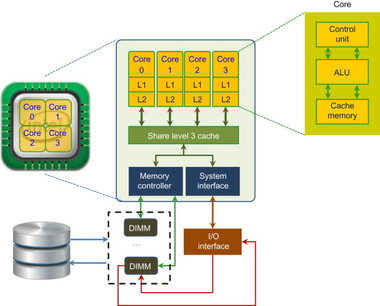











![Intel Xeon Silver [3rd Gen] 4310 Dodeca-core [12 Core] 2.10 GHz Processor - OEM Pack](https://m.media-amazon.com/images/I/41tIO-r3-FL._SL160_.jpg)



